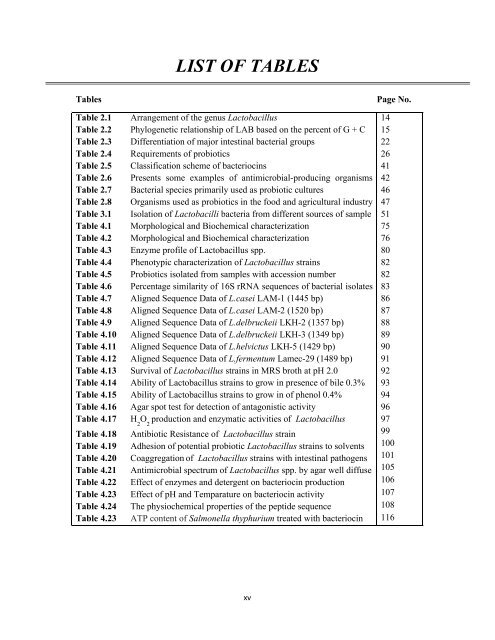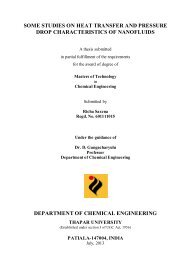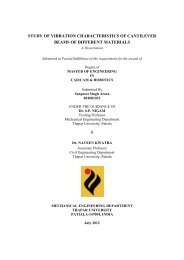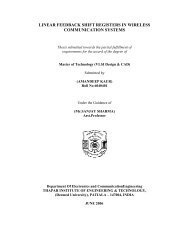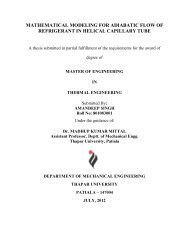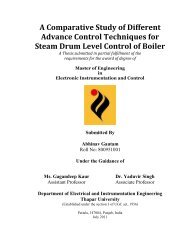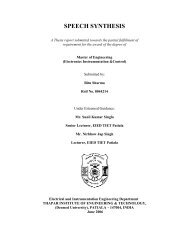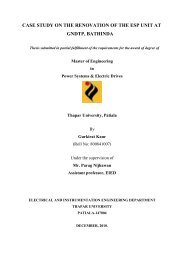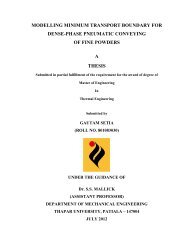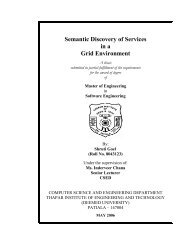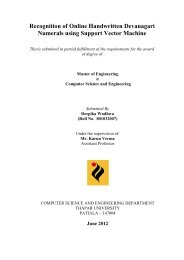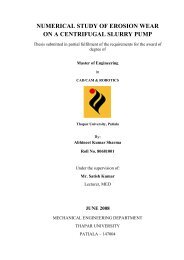from indigenous fermented foods and human gut ... - Thapar University
from indigenous fermented foods and human gut ... - Thapar University
from indigenous fermented foods and human gut ... - Thapar University
You also want an ePaper? Increase the reach of your titles
YUMPU automatically turns print PDFs into web optimized ePapers that Google loves.
LIST OF TABLES<br />
Tables Page No.<br />
Table 2.1 Arrangement of the genus Lactobacillus<br />
Table 2.2 Phylogenetic relationship of LAB based on the percent of G + C<br />
Table 2.3 Differentiation of major intestinal bacterial groups<br />
Table 2.4 Requirements of probiotics<br />
Table 2.5 Classification scheme of bacteriocins<br />
Table 2.6 Presents some examples of antimicrobial-producing organisms<br />
Table 2.7 Bacterial species primarily used as probiotic cultures<br />
Table 2.8 Organisms used as probiotics in the food <strong>and</strong> agricultural industry<br />
Table 3.1 Isolation of Lactobacilli bacteria <strong>from</strong> different sources of sample<br />
Table 4.1 Morphological <strong>and</strong> Biochemical characterization<br />
Table 4.2 Morphological <strong>and</strong> Biochemical characterization<br />
Table 4.3 Enzyme profile of Lactobacillus spp.<br />
Table 4.4 Phenotypic characterization of Lactobacillus strains<br />
Table 4.5 Probiotics isolated <strong>from</strong> samples with accession number<br />
Table 4.6 Percentage similarity of 16S rRNA sequences of bacterial isolates<br />
Table 4.7 Aligned Sequence Data of L.casei LAM-1 (1445 bp)<br />
Table 4.8 Aligned Sequence Data of L.casei LAM-2 (1520 bp)<br />
Table 4.9 Aligned Sequence Data of L.delbruckeii LKH-2 (1357 bp)<br />
Table 4.10 Aligned Sequence Data of L.delbruckeii LKH-3 (1349 bp)<br />
Table 4.11 Aligned Sequence Data of L.helvictus LKH-5 (1429 bp)<br />
Table 4.12 Aligned Sequence Data of L.fermentum Lamec-29 (1489 bp)<br />
Table 4.13 Survival of Lactobacillus strains in MRS broth at pH 2.0<br />
Table 4.14 Ability of Lactobacillus strains to grow in presence of bile 0.3%<br />
Table 4.15 Ability of Lactobacillus strains to grow in of phenol 0.4%<br />
Table 4.16 Agar spot test for detection of antagonistic activity<br />
Table 4.17 H 2 O 2 production <strong>and</strong> enzymatic activities of Lactobacillus<br />
Table 4.18 Antibiotic Resistance of Lactobacillus strain<br />
Table 4.19 Adhesion of potential probiotic Lactobacillus strains to solvents<br />
Table 4.20 Coaggregation of Lactobacillus strains with intestinal pathogens<br />
Table 4.21 Antimicrobial spectrum of Lactobacillus spp. by agar well diffuse<br />
Table 4.22 Effect of enzymes <strong>and</strong> detergent on bacteriocin production<br />
Table 4.23 Effect of pH <strong>and</strong> Temparature on bacteriocin activity<br />
Table 4.24 The physiochemical properties of the peptide sequence<br />
Table 4.23 ATP content of Salmonella thyphurium treated with bacteriocin<br />
xv<br />
14<br />
15<br />
22<br />
26<br />
41<br />
42<br />
46<br />
47<br />
51<br />
75<br />
76<br />
80<br />
82<br />
82<br />
83<br />
86<br />
87<br />
88<br />
89<br />
90<br />
91<br />
92<br />
93<br />
94<br />
96<br />
97<br />
99<br />
100<br />
101<br />
105<br />
106<br />
107<br />
108<br />
116


